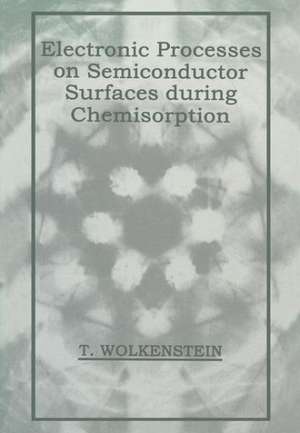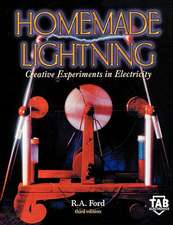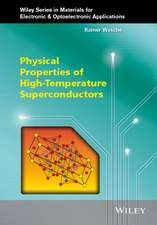Electronic Processes on Semiconductor Surfaces during Chemisorption
Autor T. Wolkensteinen Limba Engleză Hardback – 31 ian 1991
Preț: 657.36 lei
Preț vechi: 773.37 lei
-15% Nou
Puncte Express: 986
Preț estimativ în valută:
125.79€ • 134.51$ • 104.88£
125.79€ • 134.51$ • 104.88£
Carte tipărită la comandă
Livrare economică 17 aprilie-01 mai
Livrare express 13-19 martie pentru 78.62 lei
Preluare comenzi: 021 569.72.76
Specificații
ISBN-13: 9780306110290
ISBN-10: 0306110296
Pagini: 444
Ilustrații: XVI, 444 p.
Dimensiuni: 170 x 244 x 25 mm
Greutate: 0.89 kg
Ediția:1991
Editura: Springer Us
Colecția Springer
Locul publicării:New York, NY, United States
ISBN-10: 0306110296
Pagini: 444
Ilustrații: XVI, 444 p.
Dimensiuni: 170 x 244 x 25 mm
Greutate: 0.89 kg
Ediția:1991
Editura: Springer Us
Colecția Springer
Locul publicării:New York, NY, United States
Public țintă
ResearchCuprins
1. Electrons and Holes in a Semiconductor.- 1.1. Order and Disorder in Crystals.- 1.2. Electrical Conduction of Nonmetallic Crystals.- 1.3. The Mechanism of n- and p-type Conduction.- 1.4. The Energy Spectrum of an Electron in an Infinite Crystal Lattice.- 1.5. The Energy Spectrum of an Electron in a Finite Crystal Lattice.- 1.6. Statistics of Electrons and Holes in Semiconductors.- 1.7. Limits of the Band Theory of Semiconductors.- 2. The Various Types of Adsorption.- 2.1. The Main Laws of Adsorption.- 2.2. Physical and Chemical Adsorption.- 2.3. “Strong” and “Weak” Bonds in Chemisorption.- 2.4. Radical and Valence-Saturated Forms of Chemisorption.- 2.5. The One-Electron Bond in Chemisorption.- 2.6. The Two-Electron Bond in Chemisorption.- 2.7. Quantum-Mechanical Calculations in Adsorption Theory.- 3. Electron Transitions in Chemisorption.- 3.1. Transitions between Various Forms of Chemisorption.- 3.2. Adsorption Equilibrium.- 3.3. The Kinetics of Adsorption.- 3.4. The Kinetics of Desorption.- 3.5. The Role of the Fermi Level in Chemisorption.- 4. The Interaction of the Surface with the Bulk in a Semiconductor.- 4.1. The Connection between Surface and Bulk Properties of a Semiconductor.- 4.2. Effects due to the Charging of the Surface.- 4.3. The “Quasiisolated” Surface.- 4.4. Adsorptive Properties of a Charged Semiconductor.- 4.5. The Influence of the Surface on the Impurity Distribution inside a Semiconductor.- 4.6. The Adsorptivity of Semiconductor Films on Metals.- 4.7. Growth of a Semiconductor Film on a Metal.- 5. The Catalytic Effect of a Semiconductor.- 5.1. The Basics.- 5.2. The Role of the Fermi Level in Catalysis.- 5.3. Electronic Mechanisms of Catalytic Reactions.- 5.4. The Relationship between the Catalytic Activity of a Semiconductor and ItsElectronic Properties.- 5.5. The Effect of Various Factors on Catalytic Activity.- 6. Processes on a Real Surface.- 6.1. Deviations from Langmuir’s Theory on a Real Surface.- 6.2. The Adsorption-Heat Distribution Function.- 6.3. The Role of Surface Structural Defe.- 6.4. Adsorption on Dispersed Semiconductors.- 6.5. Controlling the Stoichiometry of Crystals.- 7. The Effect of Illumination on the Adsorptive and Catalytic Properties of a Semiconductor.- 7.1. The Photoadsorption Effect.- 7.2. The Photoadsorption Effect at an Ideal Surface.- 7.3. The Sign and Absolute Value ofthe Photoadsorption Effect at an Ideal Surface.- 7.4. Adsorption Centers in Photoadsorption.- 7.5. The Photoadsorption Effect at a Real Surface.- 7.6. Comparison of the Theory of the Photoadsorption Effect with the Experimental Data.- 7.7. The Photocatalytic Effect.- 8. Adsorption and Luminescence.- 8.1. Basic Facts on Luminescence of Crystals.- 8.2. The Effect of Adsorption on Luminescence.- 8.3. The Basic Laws of Radical-Recombination Luminescence.- 8.4. The Mechanism of Radical-Recombination Luminescence.- 8.5. Adsorption Luminescence.- 9. Conclusion.- 9.1. The “Local” and “Collective” Effects in Chemisorption and Catalysis.- 9.2. The Basic Concepts of the Electronic Theory of Chemisorption.- 9.3. The Electronic Theory of Chemisorption and Experiment.- References.






